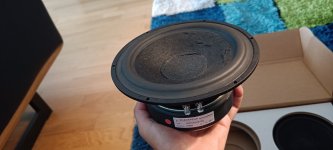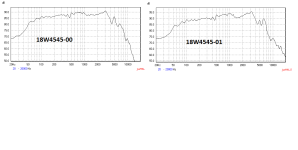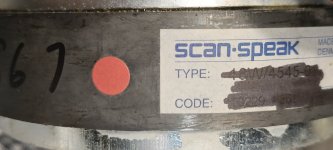why do you want broken 4545-01? I have some, but not broken. i could them broke( at reasonable fee) and sell if you want.Hey!
Do you still have some broken WP7 18W/4545-01 ScanSpeak drivers for sell?
Regards,
JR.
18w4545-00 only magnet is common to wilson audio driver. basket is diferent (bigger holes for 4545-01, cones impregantion is diferent, VC height and former material is diferent, sensitivity is diferent, frequency respose is very diferent. 4545-01 have rising response in 1-4khz and 4545-00 have completely diferent 80-300hz levels than 4545-01 . I know because in 2007 i have measured 4545-00 and comapred them to wilson audio 4545-01You can't get 18W/4545-01 anywhere, only at Wilson Audio, it was especially made for Wilson. But you can feed in 18W/4545-00 it sounds awesome direct out of the box.
I can sell only to countries where GROUND delivery is possible. Stupid airport security rules.You said you have same broken ones..Do you wanna sell any unbroken?
No, the magnet on the 18W/4545-01 is slightly bigger in diameter and about 50g heavier as the 18W/4545-00. The basket is a magnesium die cast and they are both the same!! The 18W/4540-03 is the one with the new aluminium basket with larger mounting screw holes.
Here's the picture of the 18W/4545-00, carbone fibre paper cone.
Here's the picture of the 18W/4545-00, carbone fibre paper cone.
do you compared those two drivers by yourself or just speculating? I have both drivers on hand (4545-00 and 4545-01) from the outside its clearly visible that monting holes are bigger on 4545-01, also cone stifness is diferent. 4545-00 is very soft flexible and 4545-01 is stiffer. from inside (when disasembled) diferences is even more obviuos) here is open air measurements of both drivers.
Attachments
I have both drivers cos I own W/P5.1. I Put in the 18W/4545-01 and missed the oppenes and resolution of the-00 version which has a lighter paper cone, much softer suspension and better sensitivity.
You clearly do not know what you talking about .. 18w4545-01 code is same , drivers are diferent for WP7 and WP8. I have no info on WP5 thought, but I am pretty sure its completely diferent driver than wp7/8 ,I have both WP7 and WP8 midrange drivers, they are 1.8db-3db more sensitivity than 18w4545-00. mms is 4.2g lighter. both wp7 and wp8 measurens diferently .even is code is same . Measurement dont lie.
WTF? The W/P 5 sports the 18W4545-01 code which is special made for Wilson WATT. The 18W/4545-00 is of the shelf. W/P 5 and 6 had the same driver. I think you dont know what your´re talking The moutning holes are the same 3,5mm. Later they changed to the 18W4545 -xx carbon fibre paper cones, as in the Maxx Series 2. Here´s the original W/P5 driver.
Attachments
Yes, I mean the 01 the better one, more sesitive and better soundgin as the never 00. Sorry, I missprinted the numbers.You clearly do not know what you talking about .. 18w4545-01 code is same , drivers are diferent for WP7 and WP8. I have no info on WP5 thought, but I am pretty sure its completely diferent driver than wp7/8 ,I have both WP7 and WP8 midrange drivers, they are 1.8db-3db more sensitivity than 18w4545-00. mms is 4.2g lighter. both wp7 and wp8 measurens diferently .even is code is same . Measurement dont lie.
Watching Wilson Audio's Youtube video regarding their capacitors I noticed a rather strangely looking stack of caps in the x-over. What would be the purpose of doing something like this? Instead of using single finely tuned homemade cap? No wonder they need to pot xovers to make this construction stable🙂

Many possible reasons for the multiple bypasses.
1. A non standard value which is impossible to get in their preferred capacitor type. Since they are now supposed to manufacture caps, this may no longer be a valid reason.
2. Many consider multiple bypasses with progressively smaller values to sound better than a single cap.
3. Others believe that using a cheaper capacitor for the bulk of the desired value and higher quality bypasses is a sensible way to save money.
1. A non standard value which is impossible to get in their preferred capacitor type. Since they are now supposed to manufacture caps, this may no longer be a valid reason.
2. Many consider multiple bypasses with progressively smaller values to sound better than a single cap.
3. Others believe that using a cheaper capacitor for the bulk of the desired value and higher quality bypasses is a sensible way to save money.
So it must be the second reason since 1st and 3rd are no longer valid. Thats intresting, haven't seen it in other manufacturers xovers, not that I'm some kind of expert...
Who is "many" and what basis is there for such a statement?2. Many consider multiple bypasses with progressively smaller values to sound better than a single cap.
I didn't follow this thread any further.Elviukai,
Thanks for sharing some of your measurements. I have notice, that you have studied WATT-Puppies and their drivers in depth using original Wilson speakers.
Your measurements on the WATT6 are in line with John Atkinsons findings on the later Sasha W/P, which shared similar crossover point and steepness of slopes for both midwoofer and tweeter (and later the newest Sasha DAW but with totally different drivers).
As I remember the WATT6 was Wilson’s first move towards a more musical approach compared to the former versions more analytical tendency.
View attachment 1096720
Did you ever analyse the WATT3?
It’s correct, that Wilson factory design axis for the WATT was lower than tweeter axis. However, Atkinson made the measurement at tweeter axis to comply with his measurement protocol and thus make comparisons to other speakers possible (on that given axis and distance).
But after looking at the diagrams for the frequency response here (from Stereophile), I no longer have any motivation at all about knowing the circuit topology and inductor/capacitor values of the potted crossover units, because there is a serious deficiency in this design of the crossover network:
Insufficient filter slope - only first-order, i. e. 6db/oct. and including the driver approximately 12db/oct. with bessel character.
Although 6db filters have the best properties in terms of phase and group delay behavior, but companies like Dynaudio and Wilson Audio don't take into account the fact that one never listen to the crossover network alone.
Therefore I favor third order, i. e. 18db/oct. (Butterworth, BU-III) or fourth order, i. e. 24db/oct Linkwitz Riley (LR-IV), but - very important - including the filter character of the used drivers (measured on the microphone in nearfield above 200-300Hz).
During service work on a Linn Nexus LS250 (20-25 years ago), I observe at those days that Linn had this realize very well (in terms of sound quality, a very good loudspeaker in relation to the selling price) - go to the diagrams in post #30 (second attachment) and #37 (also second attachment - my own measurement) under
https://www.diyaudio.com/community/threads/linn-nexus-ls250.254849/page-2
Unfortunately most test reviews don't show such single measurements for frequency response of each driver incl. crossover network filter. If it is show only a flat summing frequency response the extent of the overlap from drivers remains unknown, although the influence of the perceived sound character is very large.
On this Linn Nexus I further reduced this overlap area in the frequency response with a new crossover design - check out the diagrams from attachments in #37 from number 3 under
https://www.diyaudio.com/community/threads/linn-nexus-ls250.254849/page-2
The sound with new design of crossover network was clearly better, but the improvement was nowhere near as great as was the case with speakers like the Dynaudio Contour 2.8 with 6db/oct filters - i.e. the design of crossover network from this Linn loudspeaker was much more sophisticated than those from Dynaudio.
If one proceed in exactly the same way when designing the crossover for these here mentioned Wilson Audio models (Watt-Puppy/Sasha etc.) in the event that one don't want to clone them but rather build them in an improved version with the same drivers, the results in sonic performance for most people should be much more better in a listening test compared to the genuine versions, because the overlap of a very wide frequency range from two different drivers, which is still present in a crossover topology with 6db/oct (as favored by Wilson Audio unfortunately), is seen by most listeners (although not by all) as a clearly disadvantage in sonic performance.
If I had more time, I would also put this to the test with these speakers, especially since one can easily purchase very similar and in the meantime probably better drivers (except for the Focal tweeter - and I very like the T120K). - go to
https://www.scan-speak.dk/scan-speak/catalogues/#
Maybe a member from this forum want to do such a project sometime.
P.S.: The material for enclosure (cabinet) of Wilson Audio is one of the best for commercial available loudspeakers, but for diy projects a combination wood/sand is very good - as even realized on several commercial models from this company:
http://www.fmdesign.com/griffin-speaker-info/
@elviukai, would you able to help me if you still have these drivers available? The mid-woofer on one of my Watt/Puppy 7 suddenly stopped working. Checked the resistors accessible from the bottom of the enclosure, but unfortunately, the culprit seems to be an open coil. There were never driven hard, there are no burning marks or any other visible sign of stress. If anyone else could suggest an alternative solution, I would greatly appreciate! Many thanks in advance.why do you want broken 4545-01? I have some, but not broken. i could them broke( at reasonable fee) and sell if you want.
Hope I may have a similar issue that could be fixed with some care and patience. Did you do the soldering yourself or would you suggest a competent repair shop?
- Home
- Loudspeakers
- Multi-Way
- Schematic of potted crossover network for Wilson's Watt V/Puppy V.1 wanted


